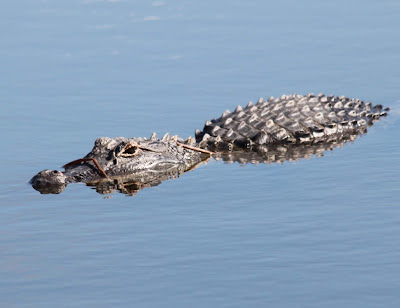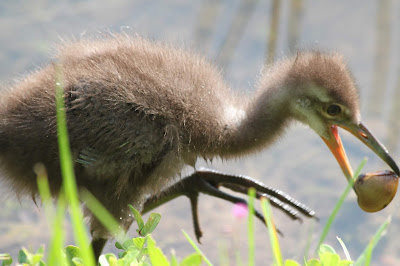When I first moved here, I thought it would be rare to see an alligator in a developed, residential, community. Wrong! Alligators are quite abundant here and I see one or two, and sometimes several, everyday in the ponds around Verandah. No matter how often I see these massive reptiles, it is always a thrill to see a prehistoric looking animal that has been relatively untouched by evolutionary change. If you went back 8 million years ago, you would see pretty much the same animal.
To spot them in the ponds, I look for blips on the surface of the water. I usually see them submerged with their eyes and nostrils above the water.
Sometimes I find them in the marshy areas along the power line road.
Alligators are not green, as depicted in children's books. If they have a greenish tinge, it is die to the algae from the pond vegetation sticking to their backs. They are generally medium to dark gray.
Sometimes they crawl up on the lawns to sun themselves. Its always a surprise to see a large gator in the backyard! Since they are ectothermic, they regulate their body temperature during cooler temperatures by basking in the sun. They are most active when it is warm.
Around here they range in size from really large ones, over 7 feet, to tiny babies like this one 3 feet long one on the grass and a 12 inch one I saw underwater. Someone in Verandah posted this photo of a clutch of babies they saw at one of the golf course ponds. Wherever there are babies, mama is nearby!
There is a very large one that travels from pond to pond nicknamed "Big Al". I think this was Big Al in the pond at Lakeview. I didn't want to get too close!
It's mating season for gators right now so they are frequently on the move around Verandah. They can be quite aggressive during mating season. Sometimes I can hear their loud, bellowing mating call. They don't have vocal chords so the sound is made by sucking air into their lungs and blowing it out.
Here are 10 interesting facts I learned about alligators:
1. Florida and Louisiana have the greatest number of alligators. There are almost 1 million alligators in Florida! That's 1 alligator to 20 people!
2. They were hunted almost to extinction in the early 1900's. The Endangered Species Act helped them recover successfully. Even though their population is large, today they are still protected by federal law as a threatened species.
3. Florida is the only place where alligators and crocodiles both naturally exist. The American alligator can be distinguished from the American crocodile by looking at the head shape. The snout of an alligator is rounded with no visible teeth showing when the jaw is closed. On the contrary, the American crocodile has a narrow snout and a tooth protrudes from the lower jaw when the mouth is closed. Florida gators are also more of a gray color and crocs are more brownish.
4. The female protects the nest and stays with her young, protecting them after they are born. This is very unusual for a reptile.
5. The temperature of the nest determines the sex of the offspring. Cooler temperatures produce females; warmer temperatures produce males.
6. They have an excellent sense of hearing. Mothers can even hear their babies calling while they are still in the egg!
7. Mating season is late Apr through June. They generally build their nests and lay 20-45 eggs in June/July. Eggs usually hatch from middle of August to early September.
8. An alligator heart has 4 chambers. Most reptiles only have 3.
9. There are two species of alligators- The American alligator and the Chinese alligator.
10. Alligaors have a powerful bite but their jaw muscles are relatively weak. A person can hold their jaw closed with their hands (but I won't try it!).



























